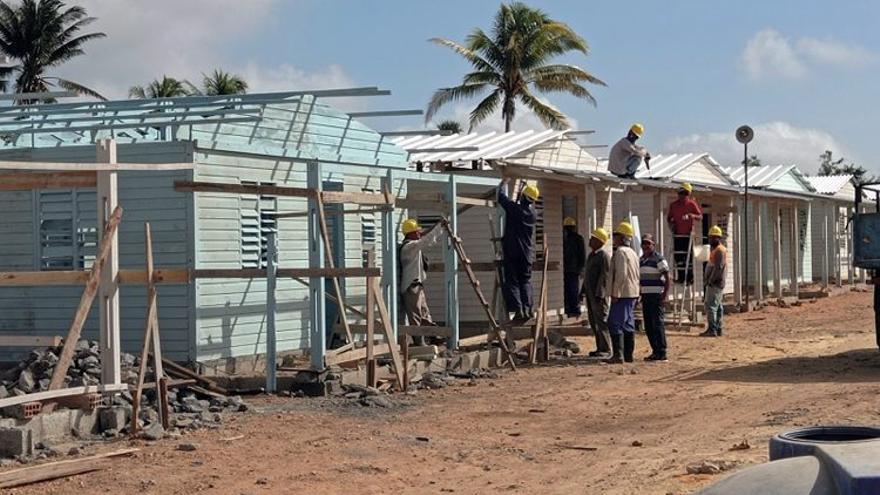
![]() 14ymedio/EFE, Havana, 27 September 2023 — Hurricane Ian, whose passage through Cuba happened a year ago this Wednesday, and which caused six deaths and significant material damage, continues to hit the population of Pinar del Río, the most affected by the hurricane. From the beginning, the Government made promises to rebuild the more than 102,000 damaged homes, but twelve months later, only 45% have been repaired. In the worst situation are the more than 12,000 residents who suffered the collapse of their homes, of which only 3% have been rebuilt.
14ymedio/EFE, Havana, 27 September 2023 — Hurricane Ian, whose passage through Cuba happened a year ago this Wednesday, and which caused six deaths and significant material damage, continues to hit the population of Pinar del Río, the most affected by the hurricane. From the beginning, the Government made promises to rebuild the more than 102,000 damaged homes, but twelve months later, only 45% have been repaired. In the worst situation are the more than 12,000 residents who suffered the collapse of their homes, of which only 3% have been rebuilt.
Luis Manuel, 48, from Pinar del Río, residing in the municipality of San Luis, says he has “lost hope” of rebuilding his house. For a year, his family has been living in an improvised structure that they built where the pigsty used to be, as he told 14ymedio by telephone. With pieces of wood and tin they created a covered space where they sleep at night and perform their daily tasks.
“Resources have arrived but everything is very poorly organized,” complains Luis Manuel. “Everything is centralized in a small group of officials who decide what materials go to each family,” he explains. “They are the ones who must review each case, and only with their signature can you go to the points of sale even if the Housing technician has already reviewed the situation of your house and has given an opinion of what is needed.”
The pinareño considers that the whole mechanism has been marked not only by slowness and lack of efficiency but also “by cronyism. From the first day, there were people who were barely affected who got zinc slabs, steel, beams and sand; but for us, who lost everything, it has been a trickle of resources, and we have not yet been able to complete the material needed to raise the walls.”
They tell us that there is no cement, that only a certain number of blocks arrived and they have to prioritize the most serious cases, but one sees that no progress is made and that those of us who are worse off are still just as bad
“They tell us that there is no cement, that a certain number of blocks arrived and they have to prioritize the most serious cases, but one sees that no progress is made and that those of us who are worse off are still just as bad,” he says. Luis Manuel’s family obtained a mattress donated by the Red Cross and received help from the Catholic Church with “medicines and some clothes.”
In the municipality of La Coloma, in the middle of the tobacco zone, the situation is similar, according to the Spanish agency EFE. “Driving through some areas,” EFE says this Wednesday in a report, “is a leap in time, as if it had barely been a few weeks since Hurricane Ian hit that area.”
The Cuban Government recently said that it intended to rehabilitate at least the “total and partial roof collapses” by the end of this year. The hurricane also took its toll on the region’s main economic activity: tobacco cultivation. According to official figures, a total of 11,554 drying houses for of tobacco leaves were completely or partially damaged, around 90% of the total. A year later, 3,816 (32%) have been completely rebuilt, and another 1,180 (9.8%) are under construction. Almost two-thirds are gone.
The absence of this key infrastructure led to about 14,826 acres being planted, just over half of those initially planned, with the consequent economic damage to producers, tobacco manufacturers and the Cuban State.
Among the testimonies collected by EFE in La Coloma, the discontent is evident. “No one has come here. Ever,” José María Puentes, 86, who lost his house, told the agency in tears. In the same way, Juan Pablo Ferreiro, 49, added: “What I can say is that no one has come here. They had a little piece of paper (a form for what you needed for your house), and it became saltwater.”
And he said he wanted to talk to Cuban President Miguel Díaz-Canel, “to tell him that he forgot about Pinar del Río.” The president, in the days after Ian’s passage, visited Pinar del Río on several occasions and La Coloma on more than one, but, according to the residents, he did not stop at the homes on the road that leads to this town.
Translated by Regina Anavy
____________
COLLABORATE WITH OUR WORK: The 14ymedio team is committed to practicing serious journalism that reflects Cuba’s reality in all its depth. Thank you for joining us on this long journey. We invite you to continue supporting us by becoming a member of 14ymedio now. Together we can continue transforming journalism in Cuba.
